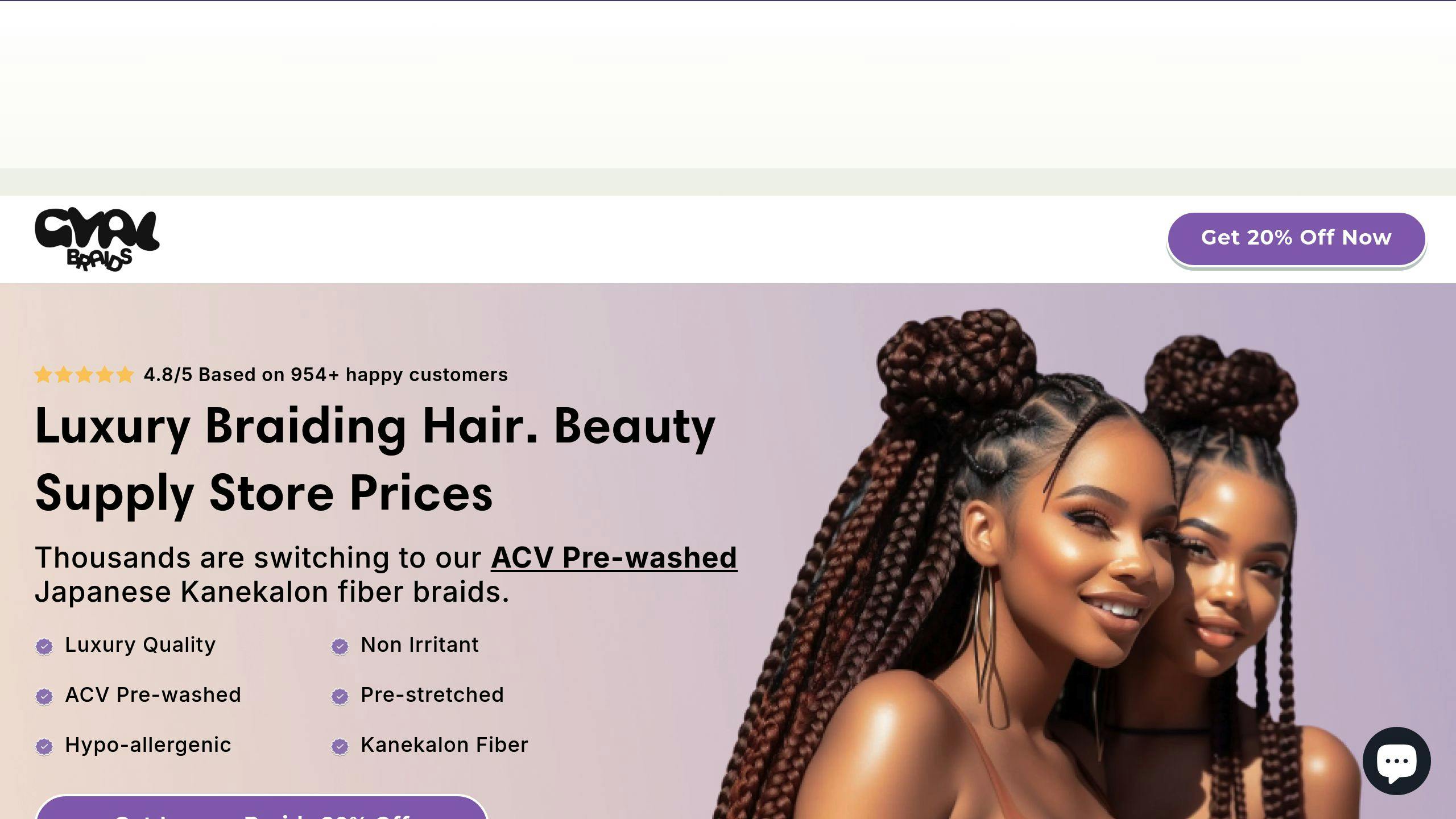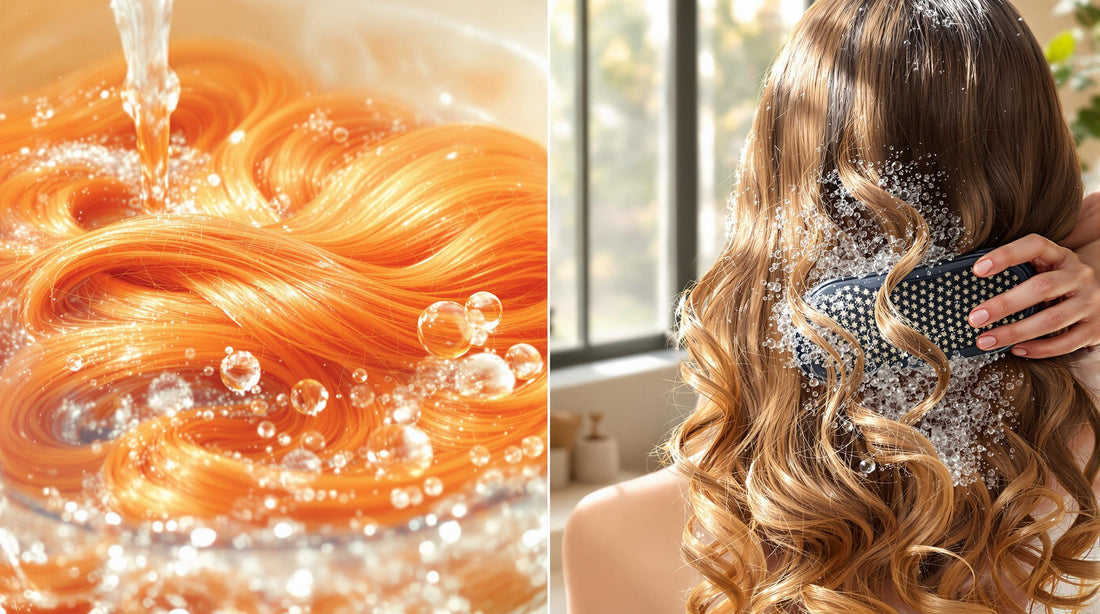Kanekalon hair and traditional synthetic hair require different cleaning methods due to their unique materials. Kanekalon is hypoallergenic, gentle on the scalp, and easier to clean, while traditional synthetic hair often includes harsh chemicals and needs delicate handling. Here's a quick breakdown:
-
Kanekalon Hair:
- Pre-clean with an apple cider vinegar (ACV) rinse to remove coatings.
- Use diluted shampoos and lukewarm water for regular cleaning.
- Hypoallergenic, reducing scalp irritation.
-
Traditional Synthetic Hair:
- Requires wig-specific shampoos and cool water for cleaning.
- Needs gentler handling to avoid tangling or damage.
- May irritate sensitive scalps without pre-treatment.
Quick Comparison
| Feature | Kanekalon Hair | Traditional Synthetic Hair |
|---|---|---|
| Scalp Safety | Hypoallergenic, irritation-free | May contain irritating chemicals |
| Ease of Cleaning | Works with natural solutions (e.g., ACV) | Needs specialized products |
| Water Temperature | Lukewarm | Cool only |
| Durability | Retains quality with care | Wears out faster with cleaning |
Kanekalon hair is ideal for sensitive scalps and low-maintenance routines, while synthetic hair requires more effort and care to maintain. Choose based on your scalp needs and cleaning preferences.
Cleaning Methods for Kanekalon and Synthetic Hair Compared
Pre-Installation Cleaning
For Kanekalon hair, an apple cider vinegar (ACV) soak is a go-to method. This soak helps remove coatings that can irritate the scalp and makes the hair fibers softer, making styling much easier [3]. This step ensures the hair is ready for safer and more comfortable installation.
With traditional synthetic hair, a gentler approach works best. Use cool water and a wig shampoo specifically designed for synthetic fibers. This keeps the texture intact while getting rid of any residue [2][4].
Cleaning During Wear
Proper maintenance during wear highlights why Kanekalon is often a better choice for sensitive scalps:
| Kanekalon | Synthetic | |
|---|---|---|
| Recommended Products | Diluted shampoos, hypoallergenic cleansers | Wig shampoos only |
| Water Temperature | Lukewarm is fine | Cool water only |
| Cleaning Frequency | As needed | Infrequently to avoid damage |
| Product Application | Works with regular mild cleaning products | Needs specialized products for synthetic hair |
Post-Removal Cleaning
After wear, cleaning is crucial to maintain the quality of both hair types. For Kanekalon hair, use a mild shampoo and conditioner, then air-dry thoroughly. This aligns with its hypoallergenic properties [2].
For synthetic hair, extra care is needed. Clean the fibers gently with cool water and wig-specific products, avoiding any wringing or twisting. Once detangled, lay the hair flat to air-dry [2][4].
"Using regular shampoos on synthetic hair can cause damage, strip away color, and make the fibers feel brittle. It is essential to use products specifically designed for synthetic wigs to maintain their texture and appearance." [2][4]
Scalp-Safe Cleaning Solutions
ACV Rinse for Kanekalon
Soaking Kanekalon hair in a mix of apple cider vinegar and warm water (1:3 ratio) for 15-20 minutes can help remove chemical coatings. This simple step minimizes irritation during installation and complements the scalp-friendly features of Kanekalon hair [3][5].
Diluted Shampoos for Synthetic Hair
When cleaning synthetic hair, stick to cool water and a mild shampoo diluted into a light solution. Handle the hair with care by following these tips:
- Use cool water: This helps maintain the fibers' condition.
- Be gentle: Avoid rough movements to prevent tangling.
- Rinse thoroughly: Make sure all shampoo is washed out to avoid scalp irritation.
Natural and Hypoallergenic Cleansers
If you prefer avoiding chemicals, natural options are a great choice for cleaning both Kanekalon and synthetic hair. Baking soda or cornstarch can effectively clean synthetic hair, while hypoallergenic products designed for sensitive skin are suitable for both types [1][2].
How to Clean Synthetic Hair Before Braiding
sbb-itb-2cead6a
Pros and Cons of Cleaning Kanekalon vs. Synthetic Hair
Kanekalon hair and synthetic hair require different approaches when it comes to cleaning and care. Kanekalon's hypoallergenic fibers allow for easier maintenance, often using natural solutions like apple cider vinegar (ACV). Synthetic hair, on the other hand, calls for specialized products and more delicate handling to prevent damage.
Here's a quick comparison of the two:
| Aspect | Kanekalon Hair | Synthetic Hair |
|---|---|---|
| Ease of Cleaning | Pre-washed options available (e.g., Gyal Braids' hypoallergenic hair) | Often needs pre-treatment |
| Scalp Safety | Hypoallergenic, less likely to cause irritation | Can cause itching or irritation if not pre-treated |
| Longevity After Cleaning | Retains quality well with proper care | May wear out faster with repeated cleaning |
| Cost of Cleaning Products | Budget-friendly with natural options like ACV | More expensive due to the need for specialized products |
Kanekalon hair stands out for its compatibility with natural cleansers, making it easier to maintain. Its hypoallergenic properties also make it a better choice for sensitive scalps, especially when pre-washed options are used. Synthetic hair, while versatile, requires more effort and investment to keep it in good condition. This highlights the importance of choosing scalp-friendly, low-maintenance options for hair care.
Conclusion and Recommendations
Key Points
When it comes to maintaining synthetic hair, three main factors stand out for long-term care:
Kanekalon hair benefits from natural solutions like apple cider vinegar (ACV) rinses, which effectively remove buildup while keeping the hair in good condition. On the other hand, traditional synthetic hair requires shampoos made for artificial fibers, needs more frequent care, and demands gentler handling.
Key differences include:
- Kanekalon hair: Requires less frequent deep cleaning, works well with natural cleansers, and holds up better over time compared to traditional synthetic hair.
- Traditional synthetic hair: Requires more specialized products and frequent maintenance, making it less convenient.
Kanekalon is a smart choice for:
- Lower maintenance expenses over time
- Compatibility with natural cleaning methods
- Reducing the chances of scalp irritation
Gyal Braids as an Option

If convenience and scalp health are top priorities, Gyal Braids provides a reliable option with their high-quality Kanekalon hair. Their pre-washed process complements the ACV rinse method mentioned earlier, making their hair ready for immediate use. The hypoallergenic Japanese Kanekalon fiber they use is designed to offer:
- A chemical-free, non-irritating experience
- Anti-bacterial properties with no unpleasant chemical odors
- Convenience for quick and easy styling
This makes Gyal Braids a great investment, offering consistent quality and minimizing the risks often associated with traditional synthetic hair.
FAQs
Can you wash kanekalon hair?
Yes, kanekalon hair can - and should - be washed regularly to keep it looking good and to prevent buildup.
How often should you wash it?
For braids worn over an extended period, wash every 2-3 weeks to keep your scalp clean and healthy [3].
How to wash kanekalon hair:
- Use a mild detergent or a shampoo specifically made for synthetic fibers (skip regular shampoos).
- Focus on cleaning your scalp using lukewarm water.
- Stay away from harsh chemicals and hot water [1][2].
Pre-Installation Tip:
Before installing kanekalon hair, try an apple cider vinegar (ACV) rinse to remove any chemical coatings and minimize the chance of scalp irritation. This step aligns with the hypoallergenic properties of kanekalon hair [3][5]. Alternatively, pre-treated options like Gyal Braids' hair save you the hassle of this initial treatment.

